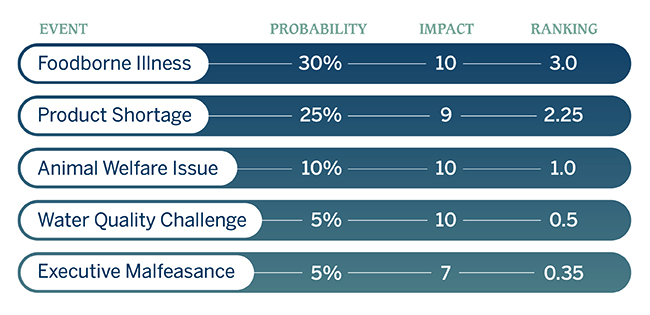6 Proactive Steps to Future-Proof Your Food Crisis Management Plan
6 Proactive Steps to Future-Proof Your Food Crisis Management Plan
While working in the food industry is one of the most fun spaces to be, we also face a plethora of risks every day. From employee and food safety to foodborne illness, environmental impact of manufacturing and various supply chain issues, one brief comment on social media from a consumer or a rumor stemming from a media source can make a detrimental impact on your business and brand image. With the rise of social media and the ability to quickly share information, rumors and bad press can spread in a matter of seconds.
As consumers continue to gain even quicker access to news online, PR communications crises are becoming increasingly common in the food industry. And according to a recent study, food-processing executives expect the number of food safety claims to rise over the next year. Six in 10 say they have already seen an increase in claims against companies. The question then becomes how we can future-proof our operations and communications strategies as much as possible to prevent a crisis before it starts – and if an inevitable disaster should occur, ways to proactively manage it to avoid long-term negative business and brand impact. Read on to snag our proven steps for successful food crisis management.
1. Live Your Values
Reducing risks of PR disasters begins with a values-driven, transparent organization. That starts with your people. Place your mission and values at the core of all your operations, and train to instill and execute against those values. This greatly reduces the risk of an event that portrays your organization in a bad light. Those same mission and values should be consistently worked into your brand narrative and across all communications channels. Share real examples of how your company or brand lives out those values, demonstrating the care and concern that goes into your day-to-day processes to keep employees and consumers safe as well as other important corporate social responsibility commitments.
If from the start your key stakeholders know how much you care because they see you make daily ‘deposits’ in the trustbank of goodwill, they are more likely to give you the benefit of the doubt when a crisis does happen.
2. Build a Robust Crisis Management Team (CMT)
Designating your crisis CMT pre-event helps position you for success when a situation arises, minimizing the fuel to the fire. CMTs can anticipate potential PR crises and prepare thoughtful organizational responses that are at the ready when needed.
Your team should have a leader assigning specific tasks to the rest of the team, from planning to preparedness drills. The most effective CMTs include a balance of PR, HR, Legal, department heads, marketing leaders, operational staff and more. Not all are activated in every case, but inclusion brings more diverse perspectives and skill sets to the table, who are prepared and ready in a crisis situation.
Senior management is a key element for a response team, especially for larger impact situations. Consumers expect to see the CEO/President as the public face, stepping up to reinforce organizational values in major events.
3. Develop Policies, Plans and Preparation Drills
As a high-risk industry, your organization should have specific protocols in place in case of a communications crisis. Policies that prevent a crisis from starting, plans for how to react if a PR crisis occurs, and a regular drill to prepare the CMT and employees for publicly addressing the situation are crucial for successfully managing the situation.
- Polices: Enforcing strict policies when it comes to employee safety, food safety and quality assurance is integral to consumer-packaged goods organizations. Not only does this reduce the risk of manufacturing mishaps, foodborne illness outbreaks and injuries, it also demonstrates that your organization strongly values employees and consumers alike. If a situation were to arise, your team can tweak the policy to ensure it doesn’t happen again and publicly share the changes being made to your operations.
- Planning: If your food brand hasn’t experienced an event such as a product recall, there’s a chance it could happen in the future – whether it’s in your control or not. While recalls are strikingly common in the food space, your response can determine your survival. No matter what the situation, having a strong plan in place will help you combat negative consequences. Common elements:
- Have a protocol in place for employee communications.
- Have a list of questions that you will likely get from the media and consumers with answers ready to go.
- Ensure your organization has contingencies in place to address supply chain interruptions/vulnerabilities.
- And finally, be sure to understand any legal or regulatory actions that might be required.
- Preparation: You can’t identify 100% of the negative events your company might experience, but a risk ranking exercise is one method to help you predict where you’re vulnerable and allocate resources to prepare your response. It’s straightforward. The members of your CMT compile a list of events that can occur and then rank them by probability of occurrence and by the potential impact on the organization. On 1%-100% probability and 1-10 impact scales, the results can help focus your preparation:

Transparency should live at the heart of how you respond. Whether retraining staff, investing in new equipment or developing new QA processes to address the issue, make sure you’re open and honest in the way you engage with your key audiences. Though a spokesperson or several individuals are usually designated to speak for the company or brand in a crisis, ensure all employees know what they say matters. Make sure they’re aware of who they’re talking with, not to get defensive, to stay calm, be cautious on social media and if approached by an identified media outlet, refer the contact to the CMT.
4. Invest in Social Monitoring Tools That Catch Negative Sentiments, Fast
Social media and press monitoring tools notify your team the moment a negative statement about your organization reaches the internet or social channels – even if your brand isn’t tagged in the post. With 80% of consumers using social media to engage with brands and 37% of consumers expecting their complaint to be addressed within 30 minutes, being able to catch these remarks sooner rather than later allows you to rapidly address the crisis before it blows up across social channels.
For our clients, we use a number of industry-leading tools to support their CMTs and PR leaders including:
5. View the Crisis as a Defining Moment
The internet is a curse and a blessing for businesses. Google searches and social media posts are the root cause of fast-spreading information, which can exacerbate a PR emergency. And while you can’t prevent every crisis from happening, you can use it to reinforce your values and reputation, depending on how you respond to the situation.
While finding yourself in a crisis certainly isn’t ideal, consumers and the media are extra tuned into your brand online. You can turn a negative into a positive by doing everything in your power to make the situation right while you have the extra attention. Along with actions being taken, you can limit damage and build goodwill through refunds, free products, and other examples of standing behind your values and offerings, and with your customers.
After a situation is resolved, make sure to update your policies, plan and preparation drills based on your key learnings and takeaways.
6. Tap into the Expertise of Food Crisis Communications Specialists
While there are plenty of steps you can follow to manage a food industry crisis, eliminating internal biases is possible by outsourcing guidance from PR and communications experts. The MorganMyers team comes with decades of experience helping food brands gain confidence in their crisis management strategies. Reach out to us today to begin future-proofing your crisis communications plan.
 Back To Blog
Back To Blog

